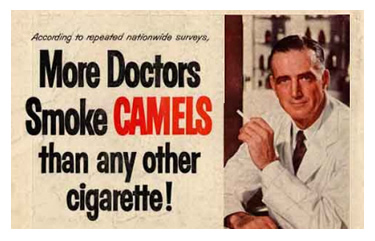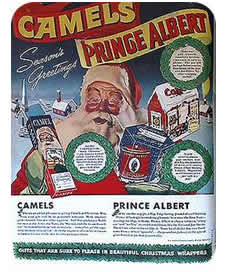 All Classic Ads Vintage Collection - Cigarettes All Classic Ads Vintage Collection - Cigarettes
Camel • Marlboro
 People have been using tobacco almost since the beginning of civilization. The evolution of tobacco use has evolved with us overtime and it has become a prevalent part of many cultures. Tobacco is a high profit crop and has been for hundreds of years. From its early uses to its modern products the tobacco plant has a unique and interesting history. People have been using tobacco almost since the beginning of civilization. The evolution of tobacco use has evolved with us overtime and it has become a prevalent part of many cultures. Tobacco is a high profit crop and has been for hundreds of years. From its early uses to its modern products the tobacco plant has a unique and interesting history.
|
|

The indian tribes of central and northern America were among the first users of the tobacco plant. Indians as early as 600 A.D. smoked tobacco. For many of these tribes tobacco was smoked during religious ceremonies using a pipe and was not used on a regular basis. Indians also smoked tobacco in pipes for medicinal purposes.
When early explorers began coming to America it was noted that tobacco was a valuable crop to the natives of the country. Many of these explorers, including Christopher Columbus were given tobacco as a gift by the Native Americans. Though these explorers brought the tobacco leaves and seeds back to europe with them its use did become popular until the early 1600s.
When the use of tobacco related products became popular, early American colonist began cultivating it their first cash crop. Eventually it became the colonist largest export. It was also the greatest source of income for the original settlers Jamestown, Virginia. The revenue derived from selling tobacco aided in funding the revolutionary war. Tobacco was even a cash crop for our very first president George Washington.
Chewing tobacco, smoking or hand rolling tobacco cigarettes became increasingly popular in the 1800s. However, at the time daily use was not common. The need for more crop and faster production eventually lead to the use of slaves in America. In the late 1800s the first commercial cigarette was made and was originally sold to civil war soldiers.
Later in 1881 a cigarette making machine was created and the first cigarette factory was opened. The first commercial cigarette brand was called Duke and Durham. Initially sales for the first commercial cigarette company were around 10 million cigarettes the first year the factory was open, but within five years one billion cigarettes were sold commercially. This company was owned the son by the maker of the first commercial cigarette Buck Duke and the maker of the first cigarette making machine James Bonsack.
The First American Tobacco Company
Eventually, Buck Duke and his father started the first American tobacco company. They called the company The American Tobacco Company. Their Company reigned supreme until the the early 1900s when Philip Morris Created the Marlboro brand cigarette. By the mid 1900s cigarette production had reached 300 billion annually.
Celebrities, Politicians, Santa, Children and Cartoon Characters
 In the early to mid 1900s, celebrities, politicians, and cartoon characters were routinely used to sell cigarettes. In this article from The New York Times, a reporter talks about a new exhibit that explores the checkered history of tobacco marketing, from blatantly false "facts" to the advertisers' desire to win over consumers at a young age. The exhibit explores the way cigarette advertising has and hasn't changed. In the early to mid 1900s, celebrities, politicians, and cartoon characters were routinely used to sell cigarettes. In this article from The New York Times, a reporter talks about a new exhibit that explores the checkered history of tobacco marketing, from blatantly false "facts" to the advertisers' desire to win over consumers at a young age. The exhibit explores the way cigarette advertising has and hasn't changed.
But how about doctors and other medical professionals, proclaiming the merits of various cigarette brands? Or politicians? What about cartoon characters in cigarette ads? Or children? Babies? Even Santa Claus?
Those images — some flabbergasting, even disturbing — were also used by Madison Avenue to peddle tobacco products. An exhibit that opens on Tuesday in New York presents cigarette ads from the 1920s through the early 1950s in an effort to demonstrate what has changed since then — and what may not have.
The exhibit, of hundreds of print ads and television commercials, is titled “Not a Cough in a Carload: Images Used by Tobacco Companies to Hide the Hazards of Smoking.” The first part of the title is borrowed from a slogan for Old Gold cigarettes, a brand that subsequently boasted in its ads of being “made by tobacco men, not medicine men.”
Small Print Camels Santa - Season's Greetings: "There's an added pleasure in giving Camels at Christmas. You know your gift will be so genuinely welcome. More smokers prefer Camels than any other cigarette. And that preference holds for men in the Army, the Navy, the Marines, and the Coast Guard, too! So remember those lads in uniform... remember all the cigarette smokers on your list... with the cigarette of costlier tobaccos - Camels. Choice of the two holiday packages above."
AVAILABLE CIGARETTE ADS BY DATE AND CATEGORY
1900 - 1919 |
1940 - 1949 |
1970 - 1979 |
|
|
|
1920 - 1929 |
1950 - 1959 |
1980 - 1989 |
|
|
|
1930 - 1939 |
1960 - 1969 |
1990 - 1999 |
|
|
|
Camel
Camel cigarettes are a brand, consisting of a blend of Turkish and American (Virginia) tobacco. Camel Cigarettes brand was introduced by U.S. company R.J.Reynolds tobacco (RJR) in 1913 and became R.J. Reynolds' first major cigarette brand and the country's first nationally marketed cigarette. Camel cigarettes have enjoyed nearly a century of outstanding success.
One of constituent parts of Camel cigarettes success is a combination of a high quality tobacco and the product's low price. They belong to 10best-selling cigarette brands. Camel Cigarettes were harmonized in a way to be smoked considerably easier in contrast to the much harsher brands popular in the period of their introduction. Balanced nicotine content and a smooth taste make Camel cigarettes a classic that will never run away.
→ click here for more information on the The Camel Company
Marlboro
The amazing Marlboro cigarette brand began in England 1847 and was initially targeted at female smokers. Aiming at this market segment was not successful, so in the 1920's Marlboro was re-targeted to female smokers in the United States. In this campaign it was stressed that Marlboro was a 'mild' cigarette. These efforts continued into World War II when the brand was eventually taken off the market.
In the 1950's Marlboro was again introduced to the market, this time on the heels of a stories about the negative health aspects of smoking. At the time, the vast majority of cigarettes being sold were non-filtered. Marlboro was a filtered cigarette, so this clearly was an attempt to win over the health conscience crowd.
Later, during the 50's, the company decided to dump the targeting of women and began promoting Marlboro as a man's cigarette. The first icon of this new change in marketing was the 'Tatooed Man' depicted on this page. Various images of healthy looking, outdoor type began showing up in ads
→ click here for more information on the The Marlboro Company |



